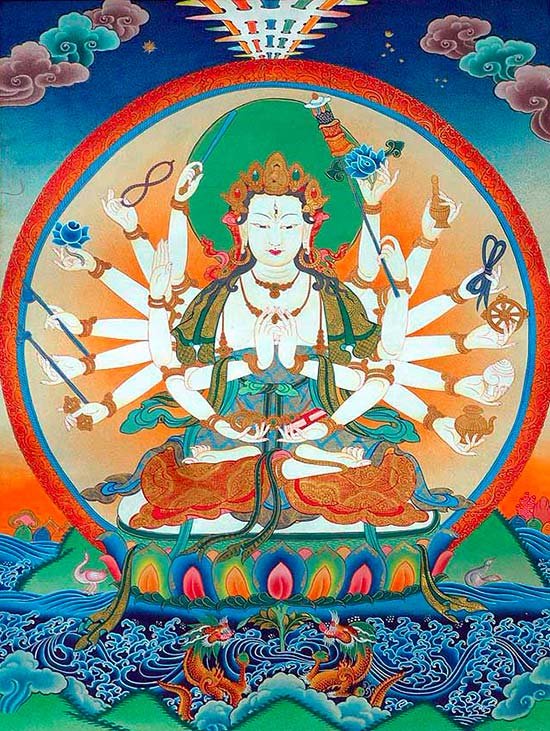Maha Prajnaparamita Sastra
by Gelongma Karma Migme Chödrön | 2001 | 941,039 words
This page describes “introduction (obtaining the first dhyana)” as written by Nagarjuna in his Maha-prajnaparamita-sastra (lit. “the treatise on the great virtue of wisdom”) in the 2nd century. This book, written in five volumes, represents an encyclopedia on Buddhism as well as a commentary on the Pancavimsatisahasrika Prajnaparamita.
Introduction (obtaining the first dhyāna)
Question. – You have already said that the first dhyāna is obtained by condemning the five desires (kāma), by avoiding the five obstacles (nivāraṇa) and by practicing the five dharmas. By what method and what path can the first dhyāna be obtained? [185c] <1025>
Answer. – By being based on the gates of absorption such as the meditation on the disgusting (aśubhabhāvana) and mindfulness of breathing (ānāpānasmṛti), etc.[1]
Thus, it is is said in the explanatory stanzas of the Tch’an king (Dhyānasūtra):[2]
Avoiding desires and bad dharmas
A person enters into the first dhyāna,
Furnished with examination (savitarka) and judgment (savicāra),
Coming from detachment (vivekaja), which is joy (prīti) and happiness (sukha).
Avoiding the flames of lust,
He is endowed with clear cool absorption.
Happy like a person who, tormented by the heat,
Enters into a cold pool.
As in the poor man who has found a treasure,
Vitarka of a great joyfulness moves his mind.
He analyzes it: this is vicāra.
This is how he enters the first dhyāna.
He knows that vitarka and vicāra disturb his mind,
Although good, he must separate himself from them,
For it is only on a calm sea
That the movement of the waves is not seen.
When a very weary man
Lies down to sleep in peace,
Any call to him
Strongly disturbs his mind.
In the same way, for the absorbed man in dhyāna,
Vitarka and vicāra are a torment.
That is why, avoiding vitarka and vicāra,
He succeeds in entering the sphere of unified consciousness
As a result of his inner purity (adhyātmasaṃprasāda),
He finds joy (prīti) and happiness (dukha) in absorption.
Penetrating into the second dhyāna,
His joy is lively and his mind is very happy.
An absorption where concentration is very strong
Is calm and free of smṛti (memory).
Annoyed by prīti (joy), the ascetic wants to get rid of it
In the same way that he has already eliminated vitarka and vicāra.
It is because of feeling (vedanā) that there is joy.
If joy is lost, sadness is experienced.
Renouncing pleasant bodily feeling (sukhavedanā),
The ascetic abandons memory and methods.
The saint (ārya) is able to reach this renunciation;
For other people, this renunciation is difficult.
When one knows the torments of happiness (sukha),
One sees the grand immobile peace.
When daurmanasya (sadness) and prīti (joy) are eliminated,
Duhkha (suffering) and sukha (happiness) still remain to be cut,
Purified by equanimity and reflection (upakṣasmṛtipariśuddha),
The mind penetrates into the fourth dhyāna.
The sukha present in the third dhyāna,
Transitory (anitya) and changing, is suffering.
In kāmadhātu, the ascetic has cut the daurmanasya;
In the second dhyāna he has eliminated the prīti.
This is why the Buddha Bhagavat
Said, in the fourth dhyāna,
Having cut the daurmanasya and the prīti,
It is necessary now to cut duḥkha and sukha.
Footnotes and references:
[1]:
These two ‘gates’ have been studied at length in Kośa, VI, p. 148–158.
[2]:
I [Lamotte] have not found these stanzas in the Tso ysh’an san mei king, T 614, p. 269c seq., Chinese translation of the Dhyānasūtra by Kumārajīva.
